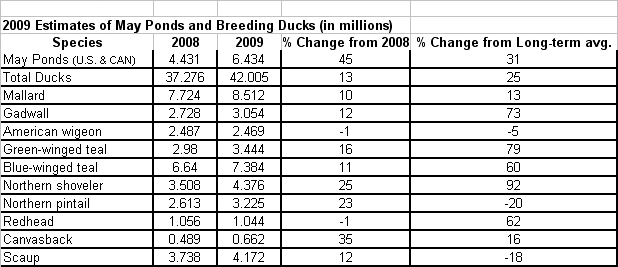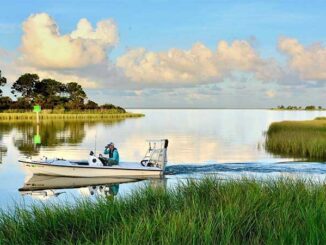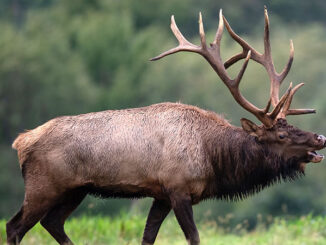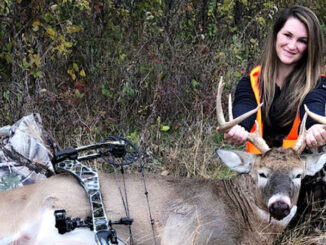
Greatly improved habitat conditions increase ducks for 2009
MEMPHIS, Tenn. – July 2, 2009 – The U.S. Fish and Wildlife Service (FWS) released its preliminary report today on mid-continent breeding ducks and habitats, based on surveys conducted in May and early June. Total duck populations were estimated at 42 million breeding ducks on the surveyed area. This estimate represents a 13% increase over last year’s estimate of 37.3 million birds and is 25 percent above the 1955-2008 long-term average.
“The increase in duck numbers in relation to the increase in habitat conditions is consistent with what we would expect to see in U.S. and Canadian breeding grounds this spring,” said Ducks Unlimited’s Executive Vice President Don Young. “History has repeatedly shown that when water returns to the breeding grounds ducks respond with a strong breeding effort.”
In addition to extensive grassland cover, one of the most important elements in duck breeding success is the amount of water present in portions of prairie and parkland Canada and north-central United States. Total pond counts for the United States and Canada combined showed 6.4 million ponds, a 45 percent increase from last year’s estimate, and 31 percent above the long-term average. Habitat conditions in 2009 were mostly a good news scenario. Conditions across the southern portions of the Canadian and U.S prairies improved considerably from 2008.
However, drought remained in some parts of the traditional survey area, including western portions of the Prairie Pothole Region. Southern Alberta saw a decrease in ponds of 19 percent. This area contrasted sharply with record amounts of snow and rainfall in the Dakotas. The north-central U.S., which includes the Dakotas, saw a 108 percent increase in total ponds. Above average snowfall this winter and considerable precipitation in late spring recharged wetlands across the Dakotas and eastern Montana.
The Canadian parklands received below-normal precipitation, but waterfowl habitat in this area continued to benefit from above-normal precipitation received in 2007. In the Boreal Forest, spring break-up was delayed as much as three weeks and most large lakes across the region remained frozen in early June. Overall habitat conditions in this important region were considered good.
The FWS spring surveys provide the scientific basis for many management programs across the continent including the setting of hunting regulations. The four Flyway Councils will meet in late July to recommend and adopt the season structure and bag limits for 2009-10. Individual states will make their specific selections within a federal framework of season length, bag limit, and outside dates. Hunters should check their state’s rules for final dates.
The 2009 report is filled with positive news for all duck species. As might be expected, most breeding populations increased as habitat conditions significantly improved from 2008 to 2009. Of the commonly surveyed species four of the 10 showed a significant increase, and six of 10 were significantly above their long-term averages.
The mallard population increased 10 percent above last year. An estimated 8.5 million mallards were on traditionally surveyed areas this spring, compared to last year’s estimate of 7.7 million birds and are now 13 percent above the long-term average.
“The increase in breeding mallard populations to numbers above their long-term average could very well be good news for hunters,” said DU’s Chief Biologist Dale Humburg. “Although we also know that migration timing and local conditions will also be important in this fall’s hunting prospects.”
Other notable increases from 2008 include canvasbacks (+35 percent), northern shovelers (+25 percent) and northern pintails (+23 percent). Pintail numbers increased for the first time since 2006, but remain 20 percent below the long-term average.
“The return of water to the north-central U.S. and much of Prairie Canada improved much of the core pintail breeding area,” said Humburg. “The strong wetland conditions likely will lead to increased pintail production and much needed recruitment into the fall flight.”
Scaup numbers were above four million for the first time since 2000. Breeding scaup numbers, however, remain 18 percent below their long-term average and continue to be a species of concern.
Other species above the long-term averages were gadwall, green-winged teal, blue-winged teal, northern shoveler and redheads. Estimated American wigeon abundance was similar to 2008 and the long-term (-1 percent and -5 percent, respectively). Although canvasbacks increased significantly from 2008 they were not significantly different in number from the long-term.
Since 1990, surveys have been conducted in eastern North America. Good habitat was found across the eastern survey area. Population estimates for the 10 most abundant species surveyed were similar to last year and to the 1990-2008 averages.
Wet and dry cycles, where water levels fluctuate over time, are vital components of maintaining wetland productivity. This is true for all wetlands, but is especially important for the prairie potholes of the northern plains. While hunters and ducks rejoice with the return of water, droughts are important in rejuvenating wetlands. As evident by this year, dedication to conservation, even through dry cycles, can pay off when water returns to the prairies and wetlands again teem with breeding waterfowl and other wildlife.
“Habitat is the core factor driving the health of duck populations and the size of the fall flight,” said Humburg. “Habitat also is a key for waterfowl in migration and for hunters. This year, spring and early summer flooding in the Midwest and South, drought in some portions of the Prairies, and extremely dry conditions in parts of the west, could affect migration and hunting habitat.”
Improvement in water conditions is only part of the story. Water without nesting cover does little to improve the duck outlook. As good as the news is this week, waterfowl and prairie habitats continue to face greater long-term threats. Grassland habitat is under siege on many fronts and is being lost at alarming rates. The U.S. Prairie Pothole Region lost more than 1.2 million Conservation Reserve Program (CRP) acres since 2007 (another 3.1 million acres will expire by 2012), and more than 3.3 million acres of native prairie are projected to be lost during the next five years.
“There has never been a time more important than today to maintain our focus on restoring and protecting these habitats, so when wet conditions return, ducks can continue to successfully produce future generations,” said Young.
For details of the Trends in Duck Breeding Populations, 1955-2009 report visit the FWS Migratory Bird website at: http://www.fws.gov/migratorybirds/


